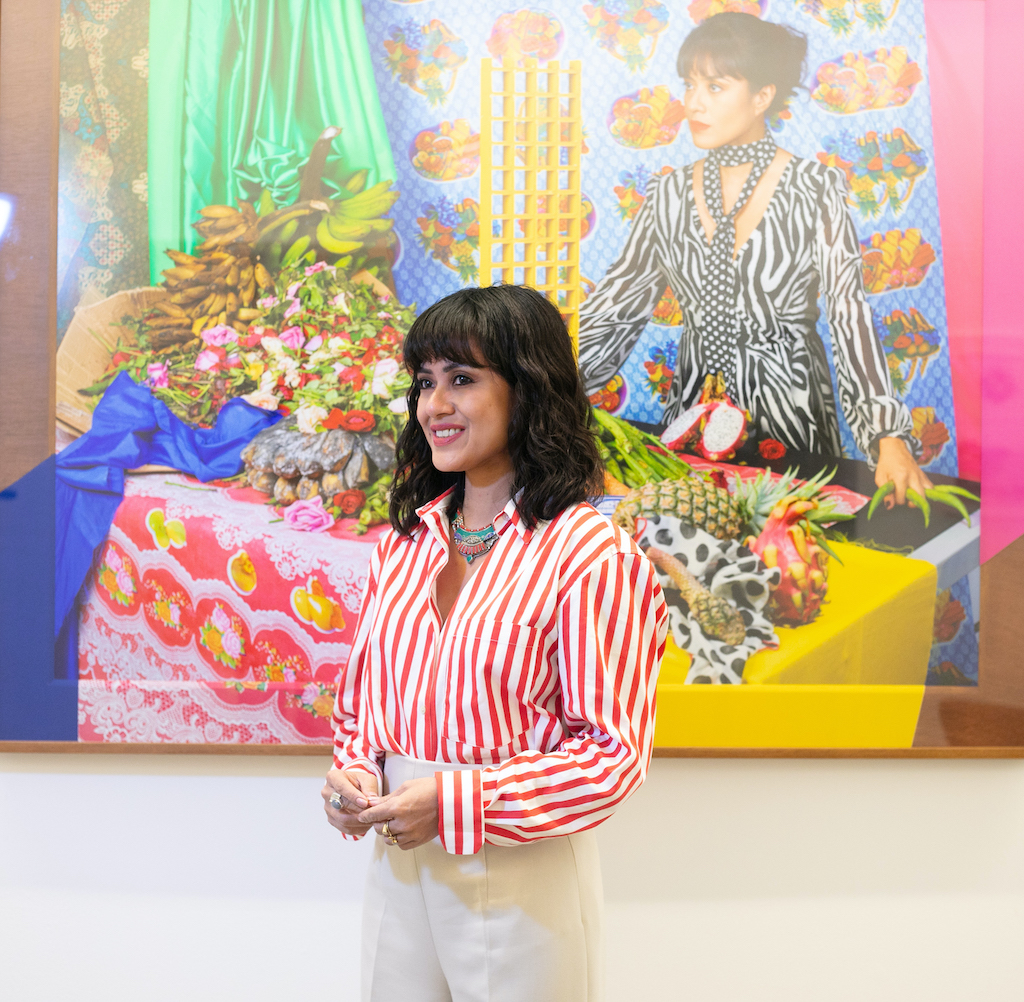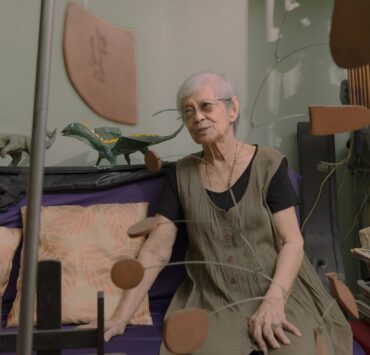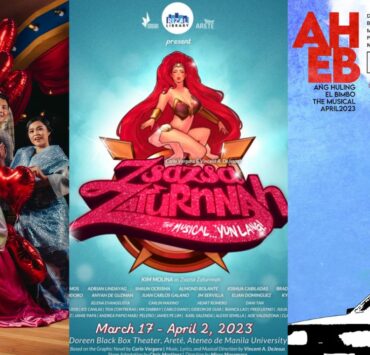One day in 2003, I decided I was going to be an artist. “What kind?” My mom inquired politely. “This kind,” I said, opening my most treasured issue of a teen magazine to a spread called “Back Off The Class” by artist Wawi Navarroza.
“What exactly am I looking at? Do you want to be a model?” she asked, a little confused.
I couldn’t blame her. The page was full of images, more collages than a fashion shoot. What was she looking at exactly? Navarroza’s occult illustrations, cut-and-paste scenes, and ballpen script lines appeared on every layout. I remember feeling stunned by the possibility the images implied. That you could take a photo and do ten million other things with it to the point that it was no longer just a photo. Layers added on not just for the sake of excess, but to convey a message. “That was probably one of the first times I ever did collage,” Navarroza tells me over a call. While a student, her early exploits in photography got her a gold medal from the prestigious Art Association of the Philippines. “I didn’t know (being an artist) was an option,” she said. “I didn’t even know what an artist looked like. I was just doing it.”
Ten years later, Navarroza is an accomplished contemporary artist and photographer whose work has been exhibited in national museums and galleries all over the world. She’s known for her emotive landscapes, constructed tableaus, and vibrant self-portraits that navigate matters of place and identity. She still employs collage in her work, albeit a little differently. In 2019, the final images of her series entitled “Self Portraits and the Tropical Gothic” were rendered to appear as if they were flat images, achieved by controlled adjustments in lighting and the placement of objects. These in-studio collages explored what would become one of the prominent visual languages in Navarroza’s work, which is what author Nick Joaquin termed as the Filipino “tropical gothic”—an intoxicating, complex mix of catholic, pagan, and the vernacular. Navarroza’s sets are full and resplendent, wall to wall with clusters of fruit, drapery, ornamentation, and household clutter. And amidst it all is Navarroza herself who is all at once the technician, head of production, photographer, and model of her own works.
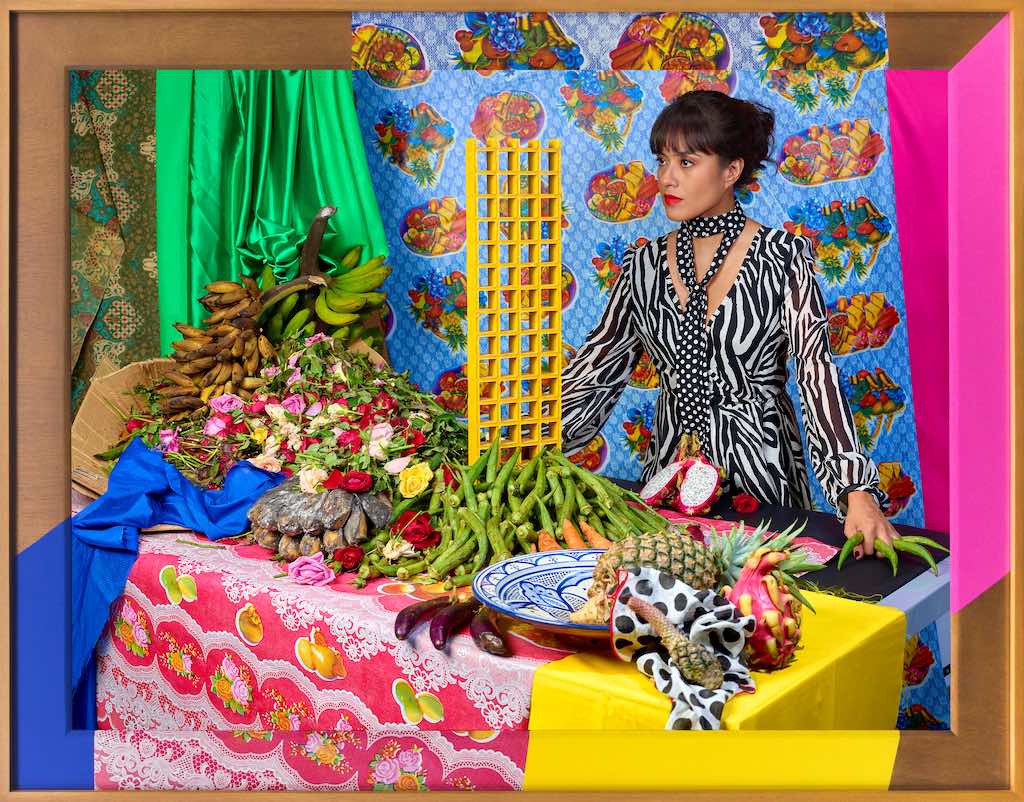
2019
Archival pigment print on Hahnemühle, cold-mounted on acid-free aluminum, with artistʼs exhibition frame i.e. wrapped fabric on double wood frame custom-tinted to WN skin tone
Photo courtesy of Silverlens Gallery
Two years ago, in the middle of the pandemic, Navarroza moved to Istanbul. There she began work on “As Wild As We Come” (2022), a continuation of her vibrant self-portraits which explored the themes of relocation, motherhood, and bodily transformation. It was first exhibited at the Kristin Hjellegjerde Gallery in London and is part of the special exhibition of the Art Fair Philippines 2023. We spoke just a few days after the devastating earthquake rocked Kahramanmaras in Southern Türkiye on February 6, when she had settled back in Manila.
Writer’s Note: If you would like to donate to the relief efforts in Türkiye, please consider donating to ahbap.org, a trusted non-government organization in Türkiye. Each donation goes toward providing shelter, food, and medical supplies to those in need.
What was the first thing you ate when you got back?
I don’t know why, but in the airport I just saw Jollibee and I said I’m going to dig in. I didn’t even have any pesos. I was so stressed out when I took the earliest flight out of Istanbul. When I arrived and I saw it, I was like, ‘Oh my god, this is home.’
Your journey as an artist has taken you to all kinds of places. For the past two years, Istanbul has been your home. For our readers who’ve never been to Istanbul—including myself—what was life like over there?
Like you, I’ve never been to Istanbul or Türkiye [before]. So that was kind of an interesting pretext to go there with a blank slate. Türkiye is the dividing point between Europe and Asia. In Istanbul, you have this body of water in the middle called the Bosporus, and if you go to the other side it’s Europe. Once you cross the bridge, it’s Asia. So literally you’re straddling between two continents and that alone is a lot of perspective to be had. Another layer to that is the history of Constantinople. Istanbul has been there since Roman times or even before that. To me, what opened up to me while living there was the ancient world. When you say Troy, Antioch, Pergamon, it’s all in Türkiye. It’s a pretty astonishing country, the doorway of what was perceived as the exotic other, the east, the unknown, mysterious, and all that.
I thought that to make self portraits were just too easy, in a sense that it may be perceived as an exercise in self-indulgence. But in my heart of hearts, I think that was the most authentic that I always had been.
Wawi Navarroza
Why Istanbul?
I moved for personal reasons, but also, while I was in Istanbul, I started with my gallery in London, and my Manila gallery expanded to New York. It became such a good base to navigate the west through London and coming back home to Manila.
I was actually surprised when we were doing the initial scheduling for this, that the time difference was only five hours. Pretty manageable.
Yeah, and the flights are also direct. It feels like a doable commute.
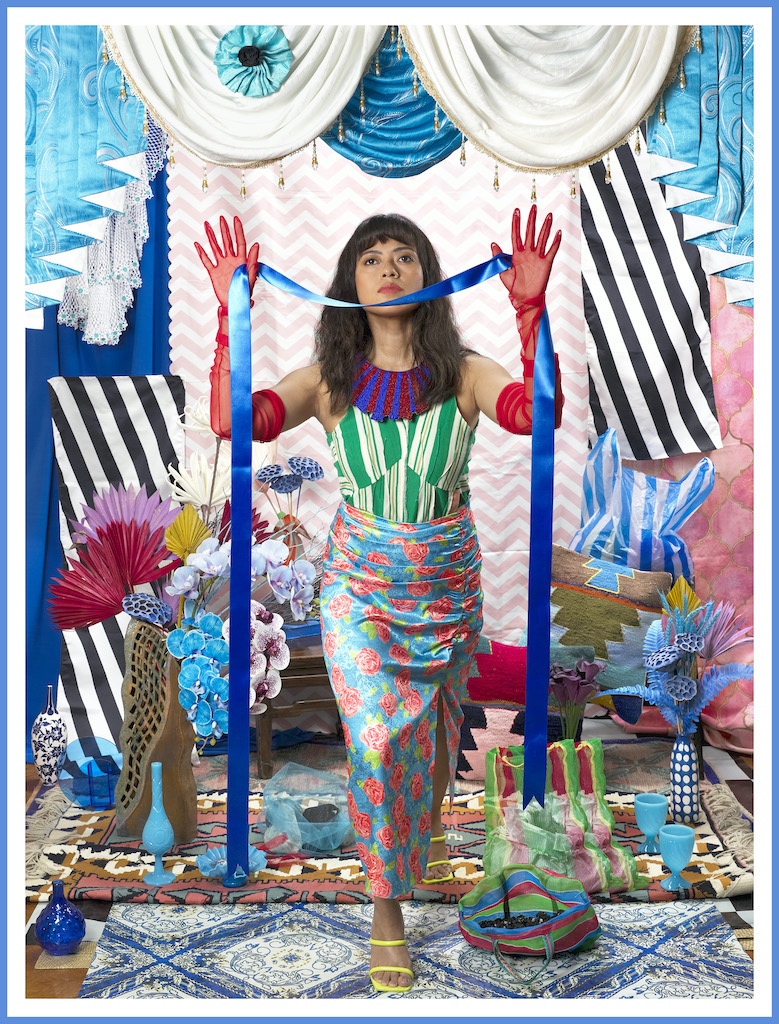
2022
Archival pigment ink on Hahnemühle Photo Lustre mounted on dibond / artist frame with wooden mat board and glazed, colored frame
Photo courtesy of Silverlens Gallery
I’d love to talk about your latest work, “As Wild As We Come.” In many ways, these works feel like a continuation of “Self Portraits and the Tropical Gothic,” which spanned several years of self-portraits. Are the works in “As Wild As We Come” all recent works?
It was a concentrated effort to encapsulate that very important time in my life and to reflect on the universal aspects of it. When you think about location and relocating, there’s that experience of transplanting. When I became a new mom, art-making stepped into the background. But this new series asserts that you can always come back, as a woman, as an artist, as a transnational Asian, as all of these things. The work is a testament to that capability of returning back into our power. Just being a woman in the art world, there’s that fraught relationship between becoming a mother and being an artist. How does motherhood change the art? How will the art world perceive you or even hold space for you? But I’m not alone in challenging this. Motherhood doesn’t remove you from being creative, it actually enhances you and it becomes such a unique vantage point. It’s also an internal transformation or a rebirth and I explored that in this series. There’s a lot to do with rebirth, transformation, going back to the body, and going back to creativity and to making.
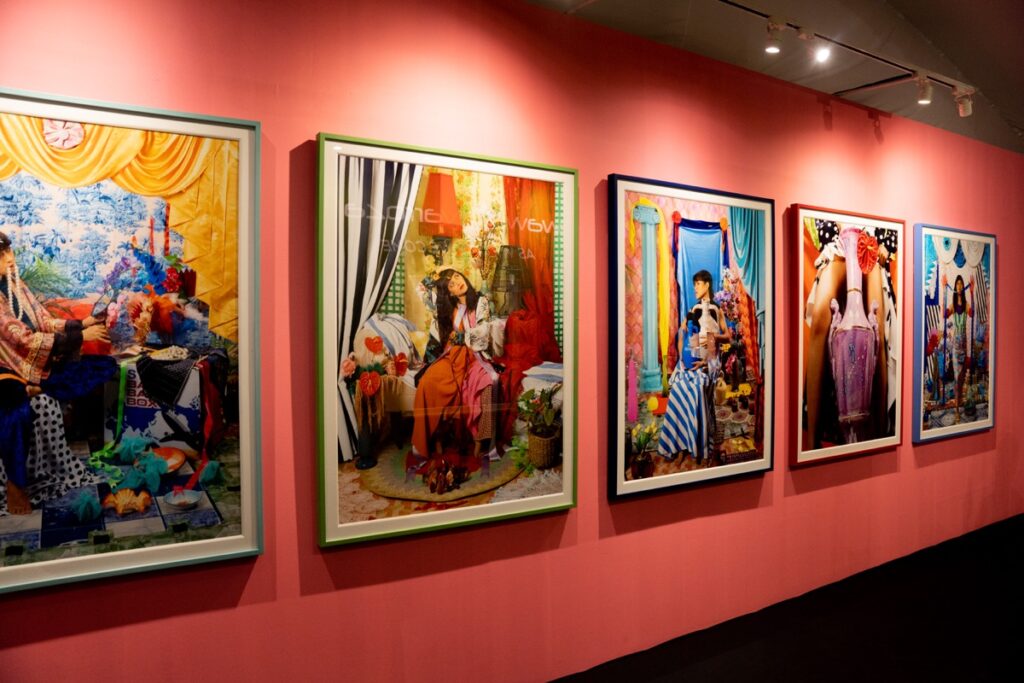
I feel like your work for “Wild” is a lot grander. More wild, if you will. I feel a lot of the sets are more elaborate, and the colors are so much more vivid. Could you tell us a little bit about the choices you made that went into creating this series?
The textural component of it is both the Filipino horror vacui and Turkish elaborate ornamentation. A lot of oriental art, whether Indian, Japanese, or Chinese, really makes use of color. It can sometimes be an emotional container for our material culture. Plus, I’ve used the sets in a way to indicate that sense of place for me. So there are lots of references to Türkiye and references to Manila. Those two places meld into one and it creates a third space which I like to call as portals to the different layers of that experience. It’s really dense. When I talk about it, I don’t know where to begin.

2022
Archival pigment ink on Hahnemühle Photo Lustre mounted on dibond / artist frame with wooden mat board and glazed, colored frame.
Photo courtesy of Silverlens Gallery
I’m glad you brought up portals, which is one of the pieces I wanted to ask about. In your piece “Portals / Double Portraits,” you have the two Wawis but your son is also in the scene. Could you tell us a little bit more about how motherhood has changed your practice?
First of all, I was one of those artists who didn’t know how it was to be a mother. I guess you become one, and it’s a process of becoming one. With “Portals,” I showed that you don’t necessarily cut out your identity to just “mother.” The figure on the left, she’s more of an Inanna Ishtar figure or an individuated self. And then the other one is a mother who’s given that identity by the child. You don’t just annihilate the other and become the mother only. It becomes another dimension to yourself that you can freely navigate. The piece is about the capability to access inner and outer worlds, which is part of a woman’s innate creativity. Women are holders of regeneration, not just by giving birth, but I mean, creativity. Just putting things out into the world.
Fabric has been a recurring element in your works. Your self-portraits, “Dominion,” and even a few older works played a lot with texture, specifically textile. I want to talk a little bit more about the textiles and fabric you used in “Wild.” We see the mantel, red lace, the sparrow blanket, and even basahan.
When I visit any place, the first thing I do is go to the market and I just go crazy with fabric. Sometimes I don’t know what to do with it and it ends up in the work. It’s also a very material way to understand a place. When we go to Bali, there’s a different fabric. Same locally when you go to Zamboanga or Ilocos. In the end, you’re amassing the stories and the material history of these places. Just softly offering the fact that these were made by hand, often by women, so there’s this underlying subtext of women’s work, which also poses a question to domesticity and everything that’s related to decor, ornamentation, and fashion. But I try to subvert that by using them as tools in the work that carry potent messages. When you layer one on top of the other, you’re looking at a world that’s made up of different places all combined in one. When you put some T’nalak in there and you juxtapose it with a mass-produced vinyl oilcloth that is being manufactured elsewhere and exported. That’s also some kind of contemporaneity in a sense, it’s not just about precious handmade fabrics, but then there’s also the reality of our contemporary world.
[W]hat I do with photography, you see literal cuts and pastes with the work, and I’m not hiding it. It’s there because it’s there to remind you that you’re looking at my opinions, you’re looking at how I see the world.

2022
Archival pigment ink on Hahnemühle Photo Lustre mounted on dibond / artist frame with wooden mat board and glazed, colored frame
Photo courtesy of Silverlens Gallery
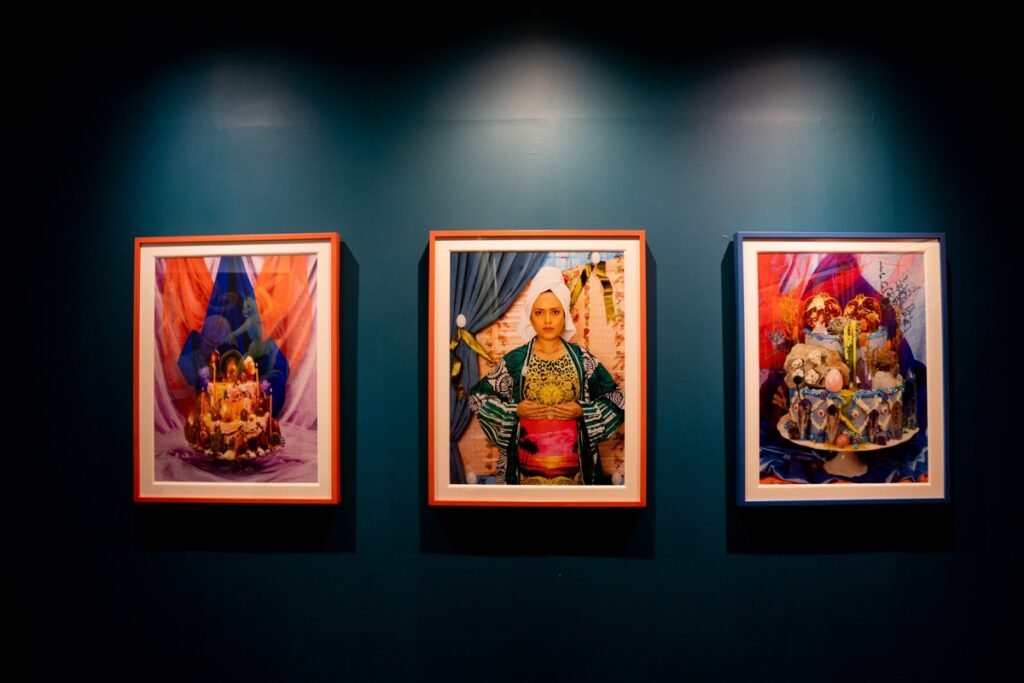
You once said in a previous interview that self-portraits are a way to reflect on life and reaffirm a life lived. But there was a time in your journey as an artist when you backed off from self-portraits to pursue other works until you eventually came back to self-portraits. Out of curiosity, what prompted this exploration?
As a younger artist, I always struggled with the fact that I was doing self-portraits. Even if I was a photographer, I seemed to be drawn to an interior world more than what was in front of my eyes. So I tried fitting myself into formats that were accessible to me. At that time, I was in a very intellectual period of my life. I was living in New York, doing a lot of theory and traveling. So I thought that making self-portraits was just too easy and that it may be perceived as an exercise in self-indulgence. And the worst nightmare at that time was to be seen as a non-critical artist. But in my heart of hearts, I think that taking self-portraits was the most authentic that I always had been. Ever since I was 17, I was already making self-portraits, whether or not they were for anyone. Neal Oshima saw some of them when I was still studying and he said “There’s something in here. Continue it.” The dividing line was when I did my homage to Frida [Kahlo]. It was my first work in color and it was received well. But I also questioned that. I didn’t want to carry on piggybacking on Kahlo or being solely associated with appropriations. But coming back to self-portraits was more of coming home to myself. I really was afraid to show who I was, so I used the landscapes to do the talking for me. They’re still a part of me today, and whenever I do self-portraits I see it larger than myself. Because in my mind, I’m everyone, especially now that I’ve become a mother. It feels like I’ve stepped into the sea of time, where you’re part of the eternal dialogue of being a human. When I’m making self-portraits, I’m thinking about other women artists before me. I’m thinking about the women who are quiet, who can’t put themselves in front and lend their voices. I want to give power to that.
When I’m making self-portraits, I’m thinking about other women artists before me, women who are quiet, who can’t put themselves in front and lend their voices. I want to give power to that.
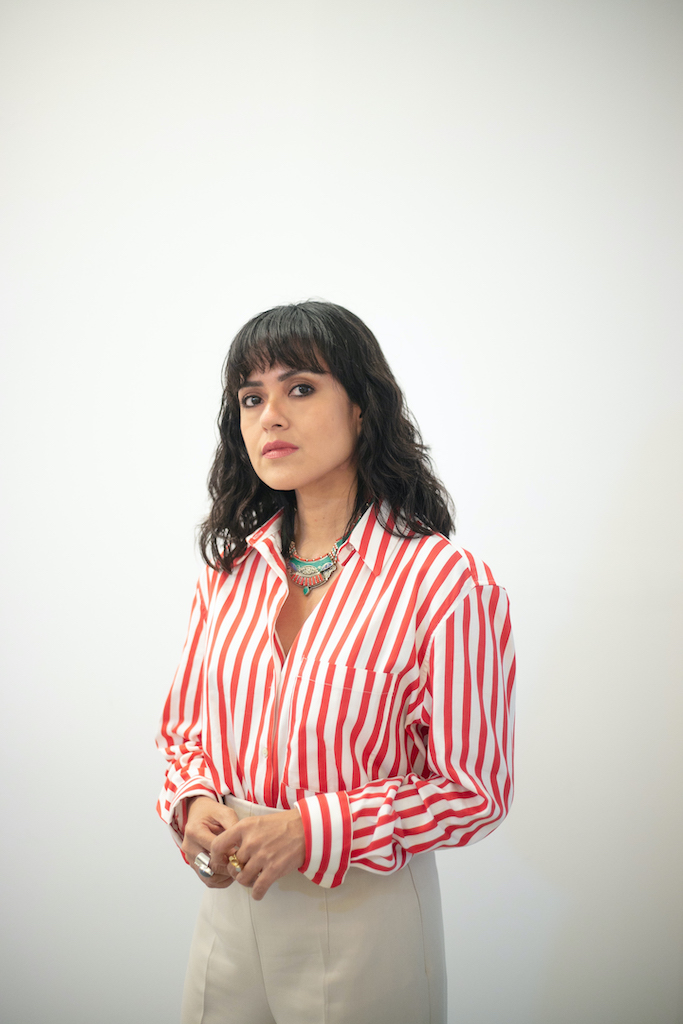
I love the idea of stepping into the sea of time. I’m honestly at a stage where people often ask me when I’m going to be a mother myself and it’s a complicated feeling.
You’re allowed to think about these things because it’s so fraught. I was there once. And I mean, I was 41 when I gave birth. [Laughs] I mean, just being a woman alone is so much. When I made those works, I hoped it would carry messages of how much we can traverse, not just bodily but interior-wise.
I’m curious though, post-COVID, another big move, and being a mother, how has your relationship to self-portraits as a medium changed? Is it still the same?
Now, in photography, I really don’t believe in not tampering with the image. I’ve already twisted the medium in so many ways. I already did that with film; I would cook them, burn them. With digital, they say you have to keep the image, if not, it’s not a real photograph. I couldn’t care less! For me, the work is not photography. It’s an image, a constructed image, just like a painting is constructed with every stroke. It’s the same with what I do with photography. You see literal cuts and pastes with the work, and I’m not hiding it. It’s there because it’s there to remind you that you’re looking at my opinions, you’re looking at how I see the world. This is the possibility of what this contemporary medium could do. Photography is not just one, it could be plural and this is the way I’m using it. It’s not photoshopped to lie. It was used to serve an intention.
Do you plan to return to Türkiye soon?
At the moment, I’m staying because I have an exhibition at the National Gallery in Singapore, so I also have some talks there. I also have some projects here. While things simmer down a little bit, I’ll get my body and my heart and spirit to rest a little bit here at home. And have my son meet his titos and titas and ninangs for a season.
Wawi Navarroza is part of the Art Fair Philippines 2023/Photo at The Link in Makati which runs from Feb. 17 to 19.


